KVN Science Highlights
- Capabilities and prospects of the East Asia Very Long Baseline Interferometry Network
- Astrometrically registered maps of H2O and SiO masers toward VX Sagittarii
- Simultaneous Survey of Water and Class I Methanol Masers toward Red MSX Sources
- Revealing the Nature of Blazar Radio Cores through Multifrequency Polarization Observations with the Korean VLBI Network
- B-field environments of a blazar S5 0716+714
- Single-epoch results of a KVN KSP: iMOGABA
- Spatially Resolved HCN Absorption Features in NGC 1052
Capabilities and prospects of the East Asia Very Long Baseline Interferometry Network
The very long baseline interferometry (VLBI) technique offers angular resolutions superior to any other instruments at other wavelengths, enabling unique science applications of high-resolution imaging of radio sources and high-precision astrometry. The East Asia VLBI Network (EAVN) is a collaborative effort in the East Asian region. The EAVN currently consists of 21 tele- scopes with diverse equipment configurations and frequency setups, allowing flexible subarrays for specific science projects. The EAVN provides the highest resolution of 0.5 mas at 22 GHz, allowing the fine imaging of jets in active galactic nuclei, high-accuracy astrometry of masers and pulsars, and precise spacecraft positioning. The soon-to-be-operational Five-hundred- meter Aperture Spherical radio Telescope (FAST) will open a new era for the EAVN. This state-of-the-art VLBI array also pro- vides easy access to and crucial training for the burgeoning Asian astronomical community. This Perspective summarizes the status, capabilities and prospects of the EAVN.
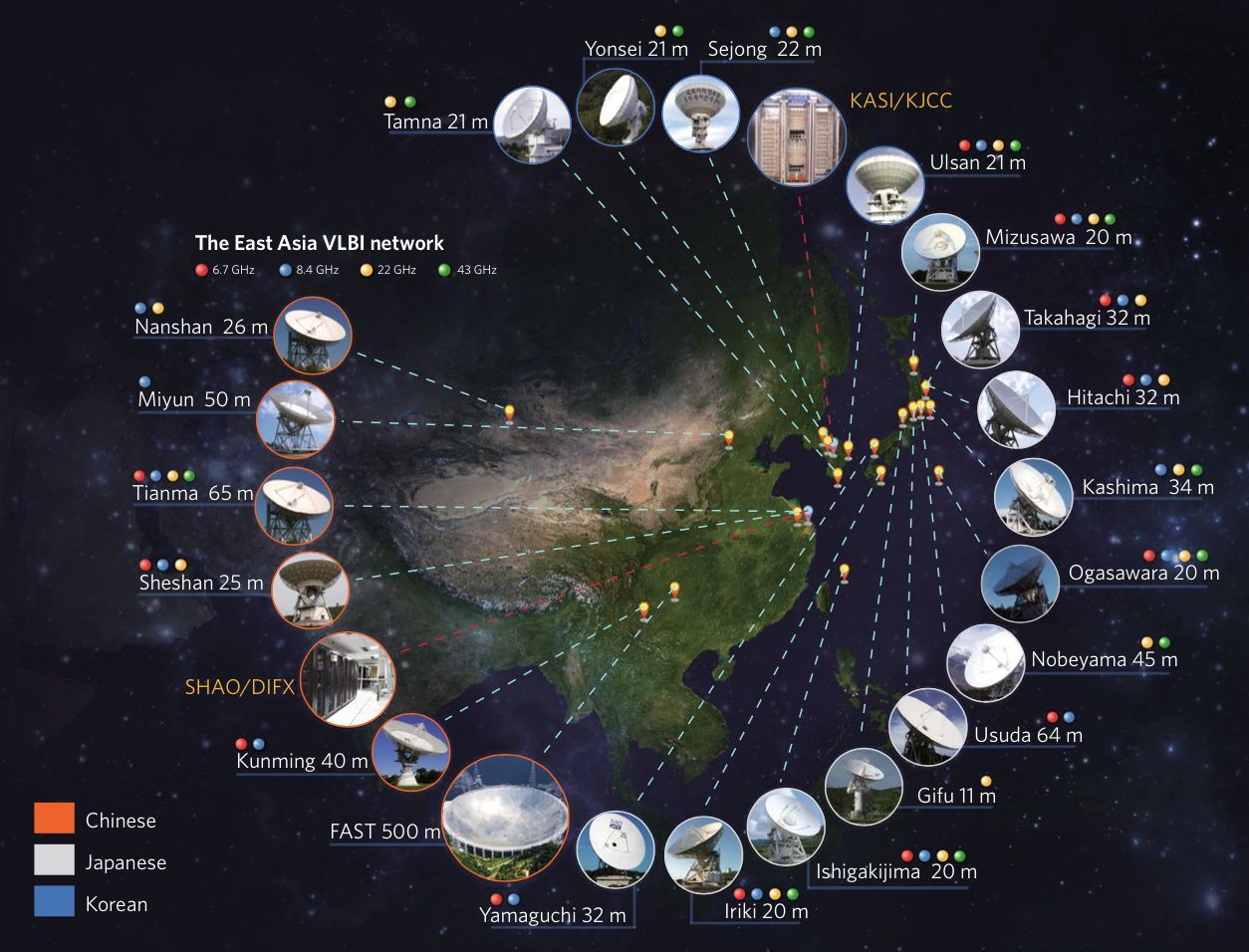
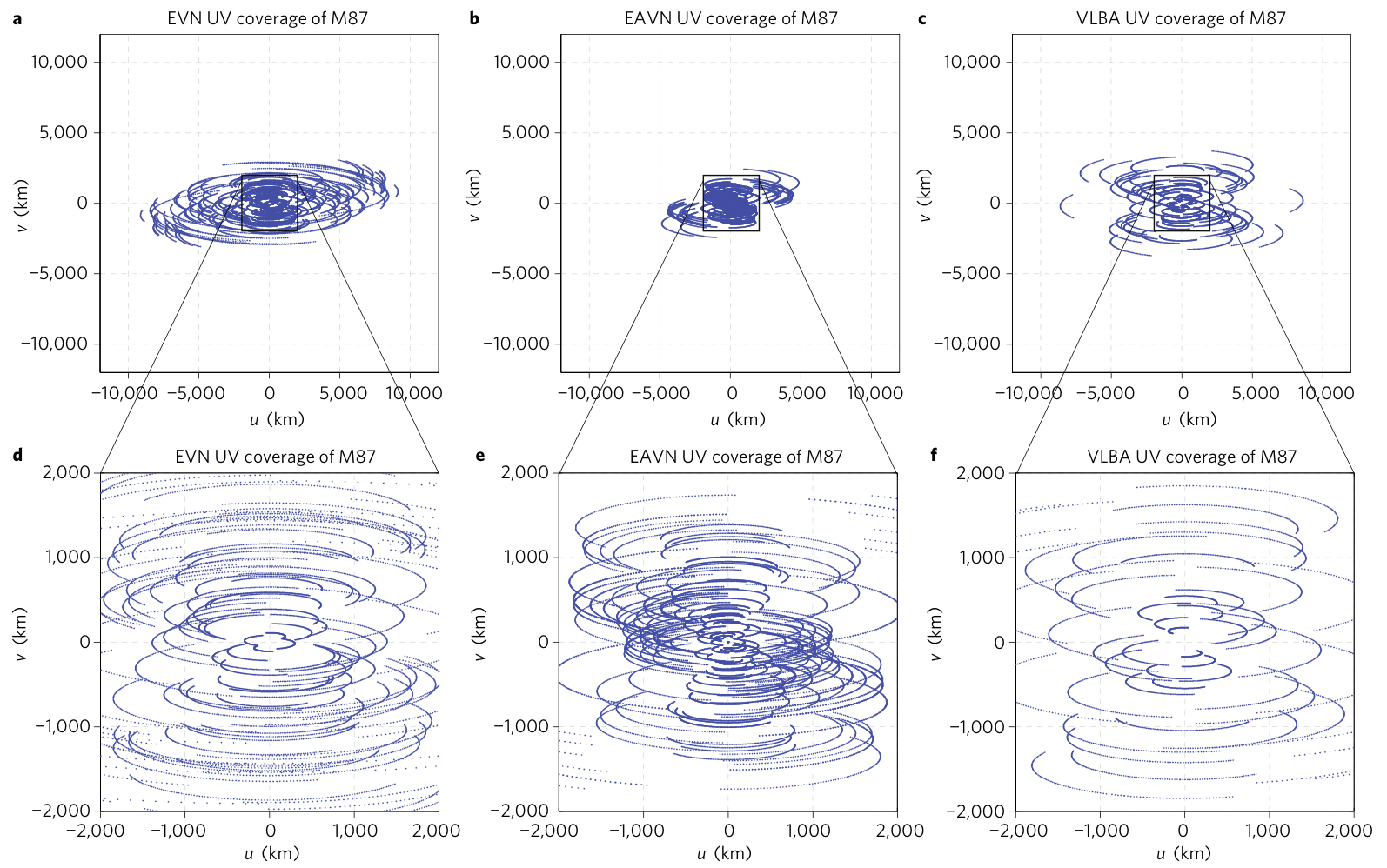
Publication: Capabilities and prospects of the East Asia Very Long Baseline Interferometry Network, 2018, Nature Astronomy 2, 118
Authors: T. An, B. W. Sohn, H. Imai
Astrometrically registered maps of H2O and SiO masers toward VX Sagittarii
The supergiant VX Sagittarii is a strong emitter of both H2O and SiO masers. However, previous VLBI observations have been performed separately, which makes it difficult to spatially trace the outward transfer of the material consecutively. Here we present the astrometrically registered, simultaneous maps of 22.2 GHz H2O and 43.1/42.8/86.2/129.3 GHz SiO masers toward VX Sagittarii. The H2O masers detected above the dust-forming layers have an asymmetric distribution. The multi-transition SiO masers are nearly circular ring, suggesting spherically symmetric wind within a few stellar radii. These results provide the clear evidence that the asymmetry in the outflow is enhanced after the smaller molecular gas clump transform into the inhomogeneous dust layers. The 129.3 GHz maser arises from the outermost region compared to that of 43.1/42.8/86.2 GHz SiO masers. The ring size of the 129.3 GHz maser is maximized around the optical maximum, suggesting that radiative pumping is dominant.
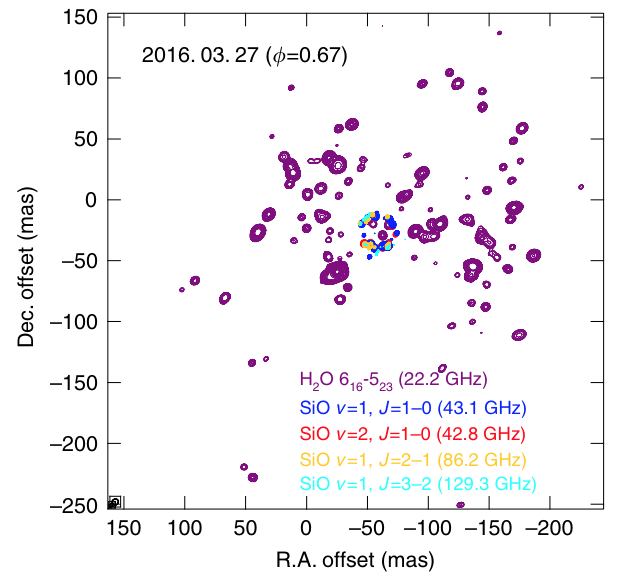
Publication: Astrometrically registered maps of H2O and SiO masers toward VX Sagittarii, 2018, Nature Communications 9, 2534
Authors: Dong-Hwan Yoon, Se-Hyung Cho, Youngjoo Yun, Yoon Kyung Choi, Richard Dodson, María Rioja, Jaeheon Kim, Hiroshi Imai, Dongjin Kim, Haneul Yang, Do-Young Byun
Simultaneous Survey of Water and Class I Methanol Masers toward Red MSX Sources
Simultaneous KVN single-dish surveys are presented for 22 GHz H2O and 44 and 95 GHz class I CH3OH masers toward 299 Red Midcourse Space Experiment Sources in the protostellar stage. The detection rates are 45% at 22 GHz, 28% at 44 GHz, and 23% at 95 GHz. There are 15, 53, and 51 new discoveries at 22, 44, and 95 GHz, respectively. We detect high-velocity (>30 km s-1) features in 27 H2O maser sources. The 95 GHz maser emission is detected only in 44 GHz maser sources. The two transitions show strong correlations in the peak velocity, peak flux density, and isotropic maser luminosity, indicating that they are likely generated in the same sites by the same mechanisms. The 44 GHz masers have much narrower distributions than 22 GHz masers in the relative peak velocity and velocity range, while 6.7GHz class II CH3OH masers have distributions intermediate between the two. The maser luminosity significantly correlates with the parental clump mass, while it correlates well with the bolometric luminosity of the central protostar only when data of the low-mass regime from the literature are added. Comparison with the results of previous maser surveys toward massive star-forming regions suggests that the detection rates of 22 and 44 GHz masers tend to increase as the central objects evolve. This is contrary to the trends found in low- and intermediate-mass star-forming regions. Thus, the occurrence of both masers might depend on the surrounding environments as well as on the evolution of the central object.
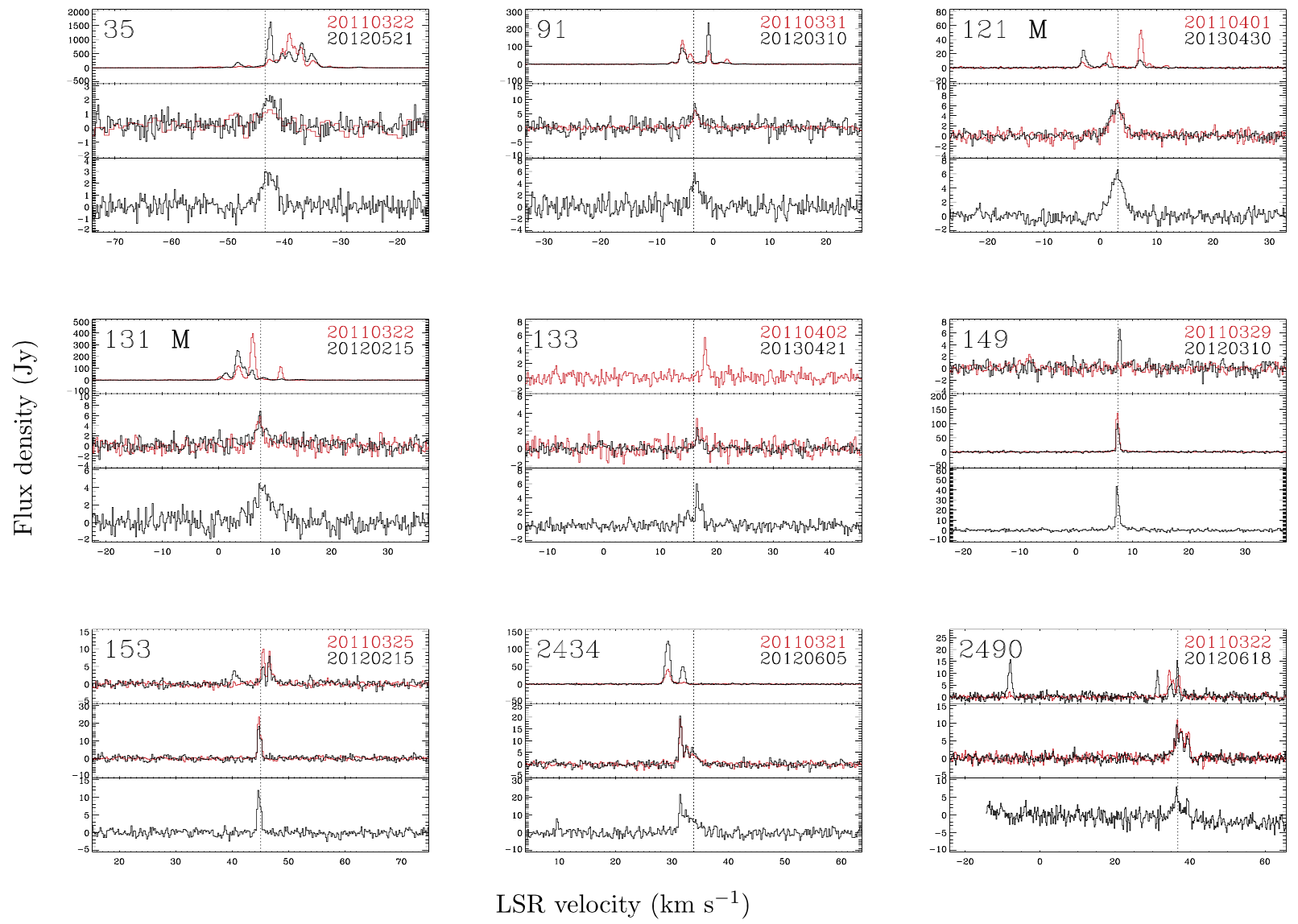
Publication: Simultaneous Survey of Water and Class I Methanol Masers toward Red MSX Sources,2018 ApJS 236 31
Authors: Chang-Hee Kim, Kee-Tae Kim , and Yong-Sun Park
Revealing the Nature of Blazar Radio Cores through Multifrequency Polarization Observations with the Korean VLBI Network
The linear polarization of the radio cores of eight blazars are observed simultaneously at 22, 43, and 86 GHz with the Korean VLBI Network (KVN) in three epochs between late 2016 and early 2017 in the frame of the Plasma-physics of Active Galactic Nuclei project. We investigate the Faraday rotation measure (RM) of the cores; the RM is expected to increase with observing frequency if core positions depend on frequency owing to synchrotron self-absorption. We find a systematic increase of RMs at higher observing frequencies in our targets. The RM-v relations follow power laws with indices distributed around 2, indicating conically expanding outflows serving as Faraday rotating media. Comparing our KVN data with contemporaneous optical polarization data from the Steward Observatory for a few sources, we find indications that the increase of RM with frequency saturates at frequencies of a few hundred gigahertz. This suggests that blazar cores are physical structures rather than simple τ = 1 surfaces. A single region, e.g., a recollimation shock, might dominate the jet emission downstream of the jet-launching region. We detect a sign change in the observed RMs of CTA 102 on a timescale of ≈1 month, which might be related to new superluminal components emerging from its core undergoing acceleration/deceleration and/or bending. We see indications for quasars having higher core RMs than BL Lac objects, which could be due to denser inflows/outflows in quasars.
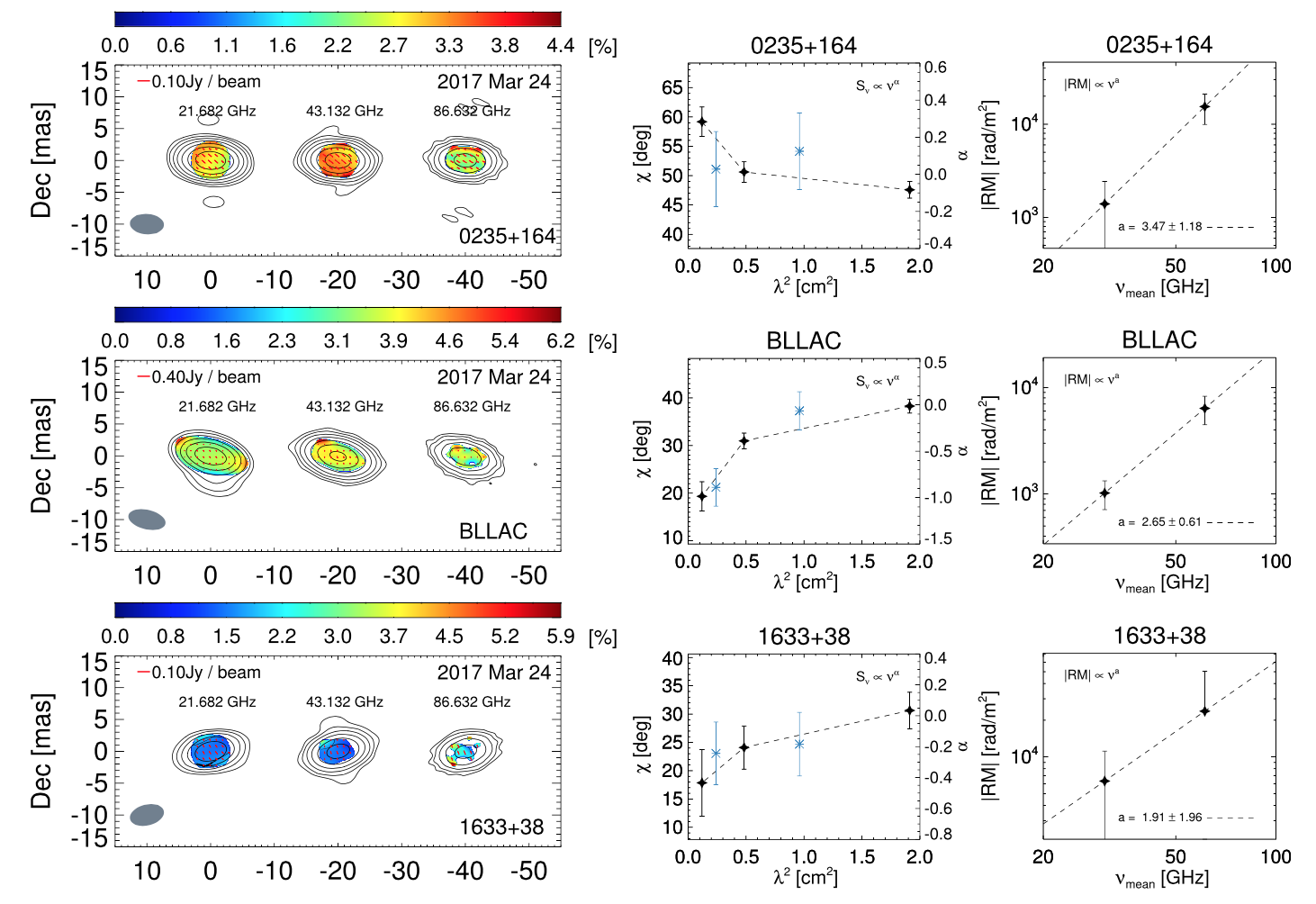
Publication: Revealing the Nature of Blazar Radio Cores through Multifrequency Polarization Observations with the Korean VLBI Network, 2018, ApJ 860, 112
Authors: Jongho Park, Minchul Kam, Sascha Trippe , Sincheol Kang, Do-Young Byun , Dae-Won Kim, Juan-Carlos Algaba , Sang-Sung Lee , Guang-Yao Zhao, Motoki Kino, Naeun Shin, Kazuhiro Hada, Taeseok Lee, Junghwan Oh, Jeffrey A. Hodgson, Bong Won Sohn
B-field environments of a blazar S5 0716+714
A KVN Key Science Program, the iMOGABA, has monitored a very compact, variable blazar S5 0716+714 simultaneously at four cm-mm bands (13mm-2.5mm) on sptial resolutions of milli-arcseconds. Observations were conducted in 29 sessions from 2013 January 16 to 2016 March 1, with the source being detected and imaged at all available frequencies. In all epochs, the source was compact on the milliarcsecond scale, yielding a compact VLBI core dominating the synchrotron emission on these scales. The turnover frequency was found to vary between 21 and 69 GHz during the observations. By assuming a synchrotron self-absorption model for the relativistic jet emission in S5 0716+714, the authors found the magnetic field strength in the mas emission region to be ≤5 mG during the observing period, yielding a weighted mean of 1.0 ± 0.6 mG for higher turnover frequencies (e.g., >45 GHz).
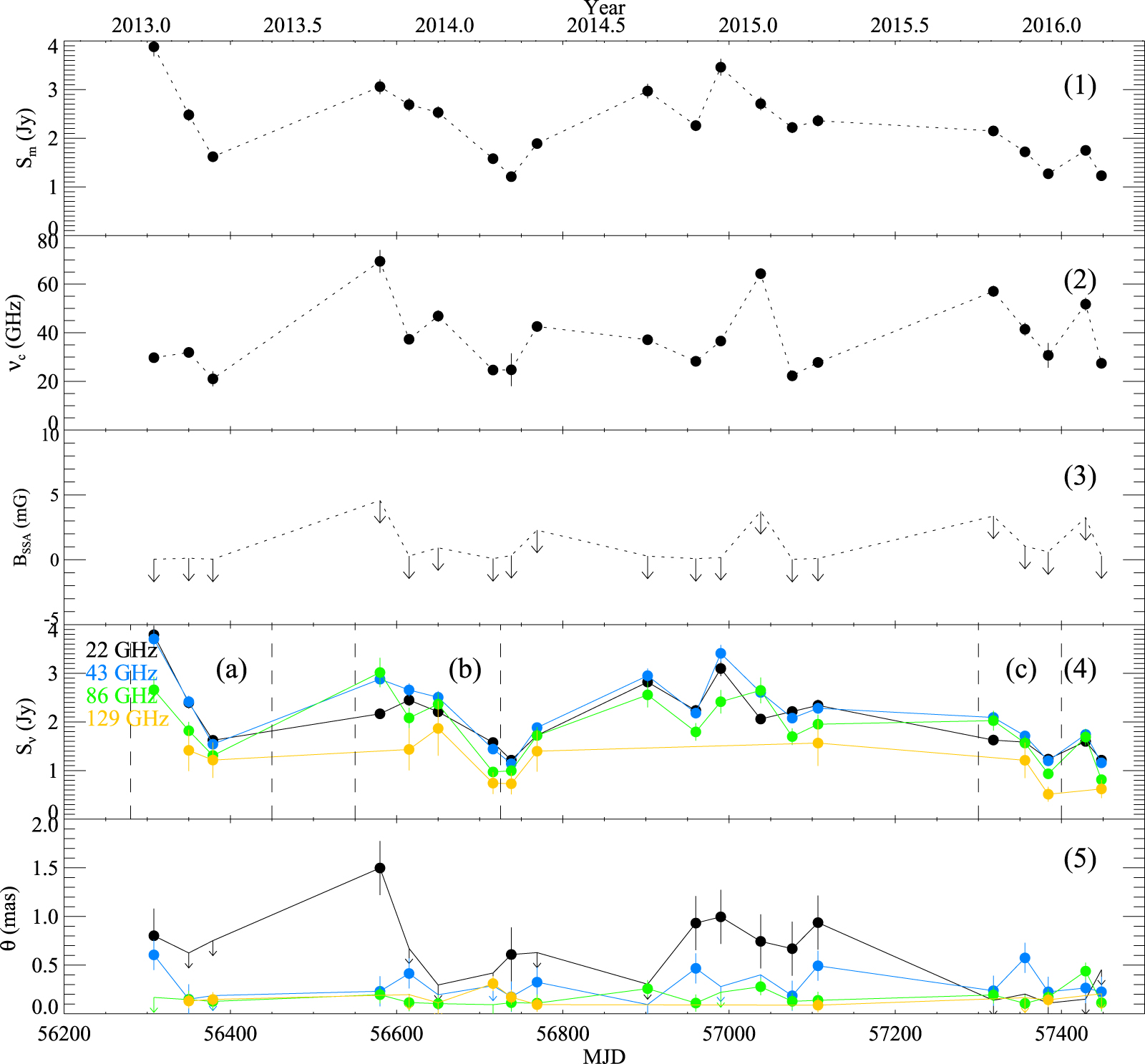
Publication: Interferometric Monitoring of Gamma-Ray Bright AGNs: S5 0716+714, 2017, ApJ 841, 119
Authors: Jee Won Lee, Sang-Sung Lee, Jeffrey A. Hodgson, Dae-Won Kim, Juan-Carlos Algaba,Sincheol Kang, Jiman Kang, Sungsoo S. Kim
Single-epoch results of a KVN KSP: iMOGABA
The iMOGABA program continues to aim at revealing the origins of the gamma-ray flares that are often detected in AGNs. One of the observing sessions in the program was conducted in 2013 on November 19 and 20, yielding 32 sources that were detected and imaged at all frequency bands with or without the use of the FPT technique. The first 129 GHz VLBI images were made from most of the sources, establishing a 129 GHz VLBI image database with a size of 32 sources. Thanks to simultaneous multifrequency VLBI observations, the authors are able to investigate the spectral properties, free from any source variability. We find that the sources become fainter at higher frequencies, yielding optically thin spectra at mm wavelengths.
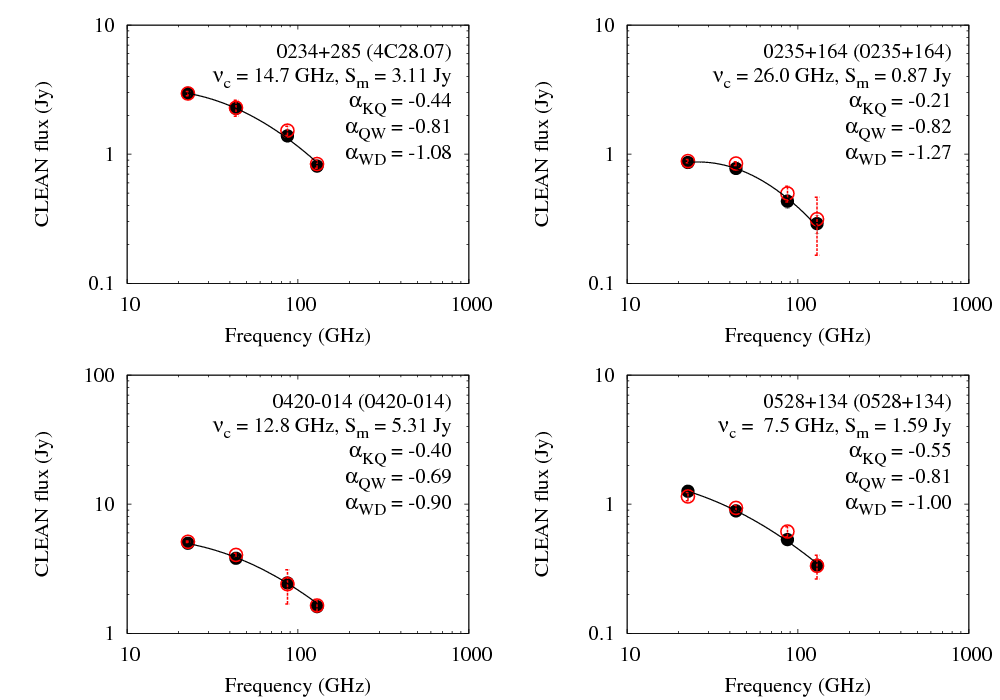
Publication: Interferometric Monitoring of Gamma-Ray Bright AGNs. I. The Results of Single-epoch Multifrequency Observations, 2016, ApJS 227, 8
Authors: Sang-Sung Lee, Kiyoaki Wajima, Juan-Carlos Algaba, Guang-Yao Zhao, Jeffrey A. Hodgson, Dae-Won Kim, Jongho Park, Jae-Young Kim, Atsushi Miyazaki, Do-Young Byun, Sincheol Kang, Jeong-Sook Kim, Soon-Wook Kim, Motoki Kino, Sascha Trippe
Spatially Resolved HCN Absorption Features in NGC 1052
The first VLBI detection of HCN molecular absorption in the nearby active galactic nucleus NGC 1052 was achieved by the KVN, spatially resolving the HCN absorption against a double-sided nuclear jet structure. Two velocity features of HCN absorption are detected significantly at the radial velocity of 1656 and 1719 km/s, redshifted by 149 and 212 km/s with respect to the systemic velocity of the galaxy. The absorption features show high optical depth localized on the receding jet side, where the free– free absorption occurred due to the circumnuclear torus. The redshifted velocities of the HCN absorption features imply that HCN absorbing gas traces ongoing infall motion inside the circumnuclear torus onto the central engine.
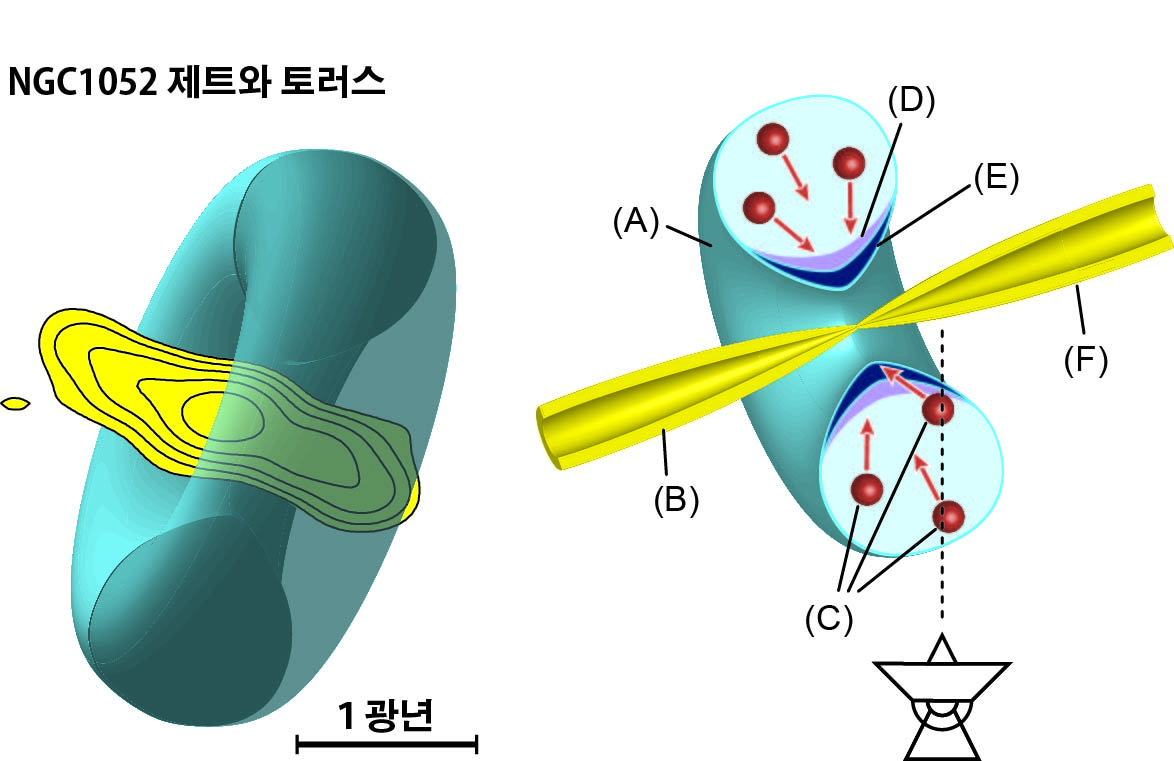
Publication: Spatially Resolved HCN Absorption Features in the Circumnuclear Region of NGC 1052, 2016, ApJL 830, 3
Authors: Satoko Sawada-Satoh, Duk-Gyoo Roh, Se-Jin Oh, Sang-Sung Lee, Do-Young Byun, Seiji Kameno, Jae-Hwan Yeom, Dong-Kyu Jung, Hyo-Ryoung Kim, and Ju-Yeon Hwang
Simultaneous Monitoring of KVN 4 Bands toward Evolved Stars
1. Science Goals
Using the characteristics of the KVN 4 band receiving system, we set up following scientific goals.
(1) We aim at investigating spatial structures and dynamical effects from SiO to 22 GHz H2O maser regions (i. e., atmosphere to circumstellar envelope) according to stellar pulsation through simultaneous monitoring observations of KVN 4 bands using both KVN single dish and VLBI network. The SiO maser lines, due to their high excitation temperature and density, are suitable for investigating nearby regions of central star which are under accelerating and decelerating by the influence of a stellar pulsation. On the other hand, 22 GHz H2O maser traces the region above dust forming layer in which outflow velocities approach to a terminal velocity of mass-loss. Therefore, both masers are good probes for investigating the development of outflow motion and asymmetry from the atmosphere to the circumstellar envelope. Furthermore, we can investigate the shock propagation effect from SiO to H2O maser regions because both masers are affected by shock waves. These works will lead us to understand how the mass-loss process is connected to stellar pulsation.
(2) Mutual association and difference between SiO and H2O maser properties are also investigated based on combined studies of SiO and H2O masers for a basis. In the last analysis, SiO and H2O maser models coupled to hydrodynamical model of circumstellar envelope should be established.
(3) We trace correlation and difference of SiO maser properties including spatio-kinematic properties among SiO J = 1-0, J = 2-1, and J = 3-2 transition masers according to different type of stars (for example, H2O strong, weak and non-detected sources, SiO v = 2, J = 2-1 rare maser detected sources). Our goal is to constrain SiO maser pumping models which are still under debate between collisional and radiative pumping models including the effects of line overlap between the ro-vibrational transitions of SiO and H2O.
(4) Through the development of outflow motion and asymmetry from SiO to H2O maser regions in individual stars at different evolutionary stages, we want to find a clue to the dynamical evolution from AGB to post-AGB stars connected to the development process of asymmetric mass-loss, for example, bipolar outflow and water fountain jet motions. In parallel, we make an effort to examine the cause of large detection rates of SiO v= 2, J = 1-0 only maser emission at late AGB evolutionary stage and different detection rates between SiO and H2O masers in post-AGB RI and LI regions which are obtained from the KVN single dish results.
2. Methods
Using both KVN single dish and VLBI network, we perform regular monitoring of H2O 22 GHz / SiO 43/86/129 GHz bands toward 15 objects of KSP (every one-two months according to their periods). Three years as the first term of KSP are required for covering at least 2 pulsation periods of 15 sources. Single dish monitoring observations at 4 bands go on being performed toward 15 objects for grasping the global features of SiO and H2O masers and for reciprocally complemented researches with VLBI. Total integration time for each target source is required for about 5 hours in order to obtain a sufficient (u, v) coverage for a good quality imaging. Therefore, we need ~350 hrs per year for VLBI monitoring and ~100 hrs for single dish monitoring. Source Frequency Phase Referencing (SFPR) technique will be adopted for registering both H2O and SiO masers using the KVN 4-bands receiving system for simultaneous observations at different bands.
3. Target Sources
| No. | Source | RA | Dec | VLSR (km/s) |
Period (days) |
SA | Calibrator |
|---|---|---|---|---|---|---|---|
| 1 | WX Psc | 01h06m25.98s | 12d35'53.0 | 8.5 | 660 | 3.81 | J0121+11493 |
| 2 | IK Tau | 03h53m28.87s | 11d24'21.7 | 35.0 | 470 | 4.04 | J0345+14531 |
| 3 | NV Aur | 05h11m19.44s | 52d52'33.2 | 3.0 | 635 | 3.19 | J0514+56021 |
| 4 | VY CMa | 07h22m58.33s | -25d46'03.2 | 18.0 | 2.78 | J0731-23412 | |
| 5 | R Leo | 09h47m33.49s | 11d25'43.7 | -1.0 | 310 | 5.52 | J1007+13563 |
| 6 | R Crt | 11h00m33.85s | -18d19'29.6 | 10.7 | 160 | 3.06 | J1048-19093 |
| 7 | W Hya | 13h49m02.00s | -28d22'03.5 | 42.0 | 390 | 4.89 | J1339-24013 |
| 8 | V2108 Oph | 17h14m19.39s | 08d56'02.6 | 16.0 | 395 | 2.45 | J1722+10131 |
| 9 | VX Sgr | 18h08m04.05s | -22d13'26.6 | 3.0 | 732 | 6.06 | J1833-21032 |
| 10 | V5102 Sgr | 18h16m26.03s | -16d39'56.4 | 48.0 | 250 | 5.99 | J1833-21032 |
| 11 | V1111 Oph | 18h37m19.26s | 10d25'42.2 | -30.2 | 3.28 | J1824+10441 | |
| 12 | V1366 Aql | 18h58m30.09s | 06d42'57.8 | 20.4 | 1424 | 7.07 | J1830+06193 |
| 13 | χ Cyg | 19h50m33.92s | 32d54'50.6 | 12.0 | 408 | 6.65 | J2015+37103 |
| 14 | RR Aql | 19h57m36.06s | -01d53'11.3 | 26.0 | 395 | 4.42 | J2015-01373 |
| 15 | V627 Cas | 22h57m40.99s | 58d49'12.5 | -52.0 | 3.43 | J2231+59223 | |
| 16 | R Cas | 23h58m24.87s | 51d23'19.7 | 21.0 | 430 | 5.65 | J2322+50573 |
Note: These sources were selected from KVN single dish and VLBI feasibility test observations. R Cas is a spare candidate source. S.A. is the angular separations from maser sources.
- 1 Detected in the KVN calibrator survey (private communication with J. A. Lee).
- 2 Detected in the source frequency phase referencing test observations (n14sc01g, n14sc01h).
- 3 Detected in the calibrator survey in 2014B pilot KSP observations (p14sc01d, p14sc01k and p14sc01o).
4. Participating Researchers
| Name | Institution/Country | |
|---|---|---|
| Se-Hyung Cho (P.I) | cho@kasi.re.kr | Korea Astronomy & Space Science Institute (KASI) |
| Youngjoo Yun | yjyun@kasi.re.kr | KASI |
| Jaeheon Kim | jhkim@kasi.re.kr | KASI |
| Yoon Kyung Choi | ykchoi@kasi.re.kr | KASI |
| Dong-Hwan Yoon | dhyoon83@kasi.re.kr | SNU/KASI (Doctor course) |
| Dong-Jin Kim | djkim89@kasi.re.kr | Yonsei Univ/KASI (Master course) |
| Sung-Chul Yoon | yoon@astro.snu.ac.kr | SNU |
| Richard Dodson | rdodson@kasi.re.kr | ICRAR (Australia) |
| Maria Rioja | maria.rioja@uwa.edu.au | OAN (Spain) |
| Hiroshi Imai | hiroimai@sci.kagoshima-u.ac.jp | Kagoshima Univ.(Japan) |
5. Candidate for Participating Researcher and Collaboration
Welcome to join KVN Evolved Star KSP. The fields are observations, pipeline post-correlation data processing (~AIPS/ParselTongue scripts), database for calibration visibilities and image cubes, scientific analyses, theoretical model fit for KVN H2O and SiO maser data etc. Please contact P. I. Se-Hyung Cho (cho@kasi.re.kr).
6. Status of Research Progress
KVN Single Dish Surveys and Monitoring Observations
At the first stage of KVN single dish operation, we have carried out simultaneous surveys of SiO and H2O masers toward 166 evolved stars which are known as both SiO and H2O maser sources. We detected both SiO and H2O masers from 112 stars at one epoch (Kim et al. 2010, Paper I). As the second and third surveys, we have carried out those observations toward previous 83 SiO-only detected sources and 152 H2O-only detected sources, respectively (Cho & Kim 2012: Paper II, Kim, Cho, & Kim 2013: Paper III). We insured a large number of new both SiO and H2O maser sources. We also performed statistical studies based on these homogeneous data (Kim, Cho, & Kim 2014: Paper IV). Simultaneous observations of SiO and H2O masers toward 252 OH/IR stars (Cho et al. 2013), 164 post-AGB and 132 AGB stars (Yoon et al. 2014), and 47 symbiotic stars (Cho et al. 2010) were added. Based on these surveys, we have also performed monitoring observations toward about 60 relatively strong SiO and H2O maser sources for single dish researches and future KVN and KaVA (KVN+VERA) VLBI observations. They are composed of semi-regular variables, Mira variables, OH/IR stars, and several post-AGB stars including water fountain sources at different evolutionary stages. From 2014A observing season, we selected 16 KVN KSP candidate sources and performed regular intensive monitoring of 22 GHz H2O and 43/86/129 GHz SiO maser lines.
VLBI Feasibility Test Observations for Key Science Program
A simultaneous fringe survey at 22/43/86/129 GHz bands was performed toward 41 sources in 2013 April (Yun et al. 2015 in prep.). The objects were selected from KVN single dish monitoring sources including 7 water fountain sources and post-AGB stars. Five frequencies of H2O: 22.235 GHz, SiO v = 1, J = 1-0: 43.122 GHz, SiO v = 2, J = 1-0: 42.821 GHz, SiO v = 1, J = 2-1: 86.243 GHz, and SiO v = 1, J = 3-2: 129.363 GHz were observed simultaneously. On source integration time was from 30 to 70 minutes depending on sources. The correlation was done with the DiFX correlator. As a result, both SiO and H2O maser fringes were detected from 15 sources among 30 both H2O and SiO maser sources (50%) at one epoch. The fringe of 129 GHz SiO maser was detected from 6 sources (17%) and fringes at all 4 bands were detected from 4 sources. The fringe detection rates of 22, 43, 86 GHz bands were 62, 83, 54 %, respectively. We also performed 4 band snapshot imaging observations toward 14 sources in 2013 May. On source integration time of snapshot was from 40 to 160 minutes. The sample snapshot images of VY CMa simultaneously obtained at 4 bands are shown in Figure 4. These results of the fringe survey and the snapshot imaging inform a promising future of simultaneous observations at four bands of KVN. We also carried out full track imaging at 4 bands toward several stars via Open Use and pilot project of KSP. All four-band images including 129 GHz were obtained from VY CMa, IK Tau (Cho et al. 2015 in prep.). For registering these different maser lines, Multi-Frequency Phase Referencing (MFPR) was highly required together with astrometry. Therefore, SFPR technique for KSP with the astrometric alignment of the SiO masers with respect to H2O maser emission are under testing like R LMi by Dodson et al. (2014).

Figure: Snapshot image of maser spots observed from supergiant VY CMa. All maser lines were observed simultaneously at 4 bands for 1 hour. From the very left panel, each image corresponds to 22 GHz H2O, 43 GHz SiO, 42 GHz SiO, 86 GHz SiO, and 129 GHz SiO, respectively. The color bar of 22 GHz H2O maser map represents the velocity along the line of sight, and the color bar of SiO maser maps represents the integrated intensity. The contour of 129 GHz SiO maser map also represents the integrated intensity.
7. Related Publications
- Jaeheon Kim, Se-Hyung Cho, Chung Sik Oh, & Do-Young Byun, "Simultaneous Observations of SiO and H2O Masers toward Known Stellar SiO and H2O Maser Sources. I.", ApJS, 188, 209 (Paper I), 2010 April
- Se-Hyung Cho & Jaeheon Kim, "Simultaneous Observations of SiO and H2O Masers toward Symbiotic Stars", ApJ, 719, 126, 2010 August
- Se-Hyung Cho & Jaeheon Kim, "Simultaneous Observations of SiO and H2O Masers toward Known Stellar SiO Maser Sources", AJ, 144, 129 (Paper II), 2012 November
- Jaeheon Kim, Se-Hyung Cho, & Sang Joon Kim, "Simultaneous Observations of SiO and H2O Masers toward Known Stellar H2O Maser Sources", AJ, 145, 22 (Paper III), 2013 January
- Jaeheon Kim, Se-Hyung Cho, & Sang Joon Kim, "Statistical Study Based on Simultaneous SiO and H2O Maser Surveys toward Evolved Stars", AJ, 147, 22 (Paper IV), 2014 January
- Dong-Hwan Yoon, Se-Hyung Cho, Jaeheon Kim, Young Joo Yun, & Yong-Sun Park, “SiO and H2O Maser Survey toward Post-AGB and AGB Stars”, ApJS, 211, 15, 2014 March
- Dodson, Richard, Rioja, María, Jung, Tae-Hyun et al., “Astrometrically Registered Simultaneous Observations of the 22 GHz H2O and 43 GHz SiO Masers toward R Leonis Minoris Using KVN and Source/Frequency Phase Referencing” AJ, 148, 97, 2014 November
- Se-Hyung Cho, Jaeheon Kim, & Youngjoo Yun, “First Detection of 22 GHz H2O Masers in TX Camelopardalis”, JKAS, 47, 293, 2014 December
- Chi-Young Cho, Se-Hyung Cho et al., “SiO and H2O Maser Survey toward OH/IR Stars” 2013 MS Thesis (Sejong Univ.), 2015 ApJS in prep
Origins of Gamma-ray Flares in Active Galactic Nuclei
1. Science Goals
A KVN Key Science Program with the title of Origins of Gamma-ray flares in AGNs (PI: Sang-Sung Lee, sslee@kasi.re.kr) is a three-year project consisting of VLBI monitoring observations (or iMOGABA) and single dish (SD) rapid response observations (RRO, or MOGABA). The VLBI monitoring observations are comprised of ten 24-hr observations per year (every month) of about 30 gamma-ray brigt active galactic nuclei (AGNs)(see http://radio.kasi.re.kr/sslee/) with Korea VLBI Network (KVN) at 22, 43, 86, and 129 GHz. The SD RROs may consist of twelve 7-hr observations per source (every week for 3 months after triggering) of gamma-ray flaring sources with two KVN SD telescopes at 22, 43, and 86 GHz (and/or 129 GHz)in dual polarization. We expect one or two sources per year for the SD RROs. Gamma-ray flares of AGNs are known to occur in innermost regions of relativistic jets which radiate in whole ranges of electromagnetic spectra due to synchrotron radiation, syschrotron self absorption, inverse-compton scttering, doppler boosting etc. Here we may eraise two questions on the natures of the gamma-ray flares of AGN such as: a) What is the basic casue of the gamma-ray flares from AGNs? b) What is the physical process of the causes? For the first question, there are several suggestions like 1) a relativistic jet of high energy plasma (Marscher et al. 2008), 2) Doppler boosting of synchrotron radiation of the jet (Dermer 1995), 3) inverse Compton scattering by relativistic electrons, etc. For the second question, we may find some candidates and detail mechanism for the gamma-ray flares such as 1) compression and heating of the plasma in the relativistic jets, 2) generation of the relativistic particles, 3) rapid variability in flux and magnetic field. In order to answer to the questions, we may conduct either 1) studies of large samples of flaring AGNs for investigating statistics and correlation of observed properties (Lister et al. 2011), 2) multi-wavelength observations of individual objects for testing time profiles of flares (Jorstad et al. 2010), for studying physical properties of emission features (jet knots) (Agudo et al. 2011), and studying evolution of SEDs (Wehrle et al. 2013), or 3) polarization observations for looking at magnetic field environments (Jorstad et al. 2013). Possible explanations of the gamma-ray flares in AGNs are a) shocks-in-jets propagating within jet flow and b) bending of the whole jets. For both cases, we should expect changes in polarization, luminosity, particle distribution, and structures of jets at mas-scale. The multifrequency simultaneous VLBI/SD observations with KVN are the best tool for detecting such changes correlated with gamma-ray flares. This KSP aims to answer the fundamental questions about the basic nature of the flares of AGN.
2. Observing Strategy
The observations consist of ten 24-hr VLBI observations per year from 2015 January to 2018 January of about 30 gamma-ray brigt active galactic nuclei (AGNs) with Korea VLBI Network (KVN) at 22, 43, 86, and 129 GHz. Ten observations will be conducted every month. Our first priority is to measure changes of jet structures at mas-scale of about 30 γ-ray bright AGNs when they are flaring in the gamma-ray. Our targets are chosen to have flares in gamma-ray detected with Fermi-LAT gamma-ray space telescope (see http://radio.kasi.re.kr/sslee/). Since most of them are very bright at KVN’s operating frequencies, they are able to be detected at KVN baselines within coherence times (20-100 sec) at correponding frequencies. However, we have confirmed that it was possible to improve fringe detection sensitivity with longer integration time than canonical coherence times. Therefore, we observe each source with several 5-min-long scans distributed over its LST time range in order to have uniform uv-coverages. With this snap-shot mode observations, we are able to detect sizes and flux densities of compact jets. However, some target sources with complicated jet structures at KVN’s resolution should be carefully imaged. This issue may be resolved with full-track observations for each sources. Our second priority is to measure flux density changes of AGN jets at mas-scale. Since atmospheric fluctuation are very high at millimeter wavelengths, careful amplitude calibration should be conducted for individual observations. For usual VLBI imaging observations, one can self-calibrate the amplitude with closure-amplitudes. However, unfortunately, with only three antennas of the KVN, the amplitude self-calibration is not possible. Therefore, we conduct very frequent measurements for atmospheric opacity (every hour) and antenna system noise temperature (every scan). More importantly, constant monitor and adjustment for antenna pointing (and/or focus) are performed.
3. Target Sources
Please see http://radio.kasi.re.kr/sslee/ for the list of target sources in addition to calibrators in this project.
4. Team Members
The KVN KSP is a joint project based on the contributions from the following members:
KASI (Korea)- Sang-Sung Lee (PI)
- Do-Young Byun (MOGABA data reduction pipeline)
- Jeffrey Hodgson (iMOGABA data reduction pipeline, 3C84)
- Sincheol Kang (MOGABA observations/data reduction, 1156+295)
- Jeong-Sook Kim (CygX-3)
- Soon-Wook Kim (CygX-3)
- Jee Won Lee (iMOGABA data reduction, 0716+714/OJ287)
- Kiyoaki Wajima (iMOGABA data reduction, faint AGNs)
- Guangyao Zhao (iMOGABA with frequency phase transfer)
Seoul National University (Korea)
- Juan-Carlos Algaba-Marcos (iMOGABA data reduction, 1633+382)
- Dae-Won Kim (iMOGABA data reduction, BL Lac, 1749+096, 0836+710)
- Jongho Park (iMOGABA data reduction, 1510-089)
- Sascha Trippe (bright AGNs)
Kogakuin University (Japan)
- Motoki Kino (bright AGNs)
Max Planck Institute for Radio Astronomy (Germany)
- Jae-Young Kim (iMOGABA data reduction, M87)
5. Related Publications
Please see a list of papers that have been published using the data from MOGABA and iMOGABA projects.
The Plasma-physics of Active Galactic Nuclei (PAGaN)
1. Overview
A fraction of all active galactic nuclei (AGN) shows extended, highly collimated outflows of gas – jets – from their centers. This phenomenon is probably caused by an interplay of black hole rotation, accreted matter, and magnetic fields (the Blandford–Znajek mechanism). For a rapidly spinning Kerr black hole, the innermost stable circular orbit, and thus the inner edge of the accretion disk, can be located within the ergosphere. This permits the transfer of rotational energy from the black hole to the accreted matter. In addition, accretion disks are likely to be permeated by magnetic fields. Within the ergosphere, magnetic field lines will be twisted by frame-dragging, thus forming “tunnels” or “chimneys” made of magnetic field lines. A part of the material in the innermost parts of the accretion disk will be ejected along those magnetic “tunnels”; the magnetic field keeps the material collimated even over large distances, leading to jets ranging over a few megaparsecs in the most extreme cases. However, despite their importance, none of the key features of AGN jets – their launching, collimation, propagation, and interaction with interstellar gas – is understood. AGN jets are objects of ongoing research and their physical properties are hotly debated.
The PAGaN project analyzes the physical – especially plasma-physical – properties of selected AGN via multi-frequency polarization monitoring with KVN. It observes polarization both as function of time and frequency, thus constraining the evolution and propagation of shocks, particle densities, and magnetic field geometries.
2. Observing Strategy
PAGaN exploits the unique capability of KVN to observe the full polarization state of a source at four cm-to-mm frequencies spanning a factor six in frequency. PAGaN observes seven radio-bright AGN twice per year and uses dual-frequency phase referencing to improve the quality of the 86 and 129-GHz data. For each source, linear polarization maps are constructed and rotation measures as function of frequency are calculated.
Throughout 2016, a limited number of observations has been obtained in order to test the feasibility of the project. After a successful proof-of-concept, regular observations will begin in 2017. The KVN data will be complemented by archival VLBA, SMA, optical, and gamma-ray data to provide a multiwavelength view on the selected targets.
3. Target Sources
BL Lac, 3C 111, 3C 120, 3C 273, 3C 345, 4C +11.69, 4C +21.35
4. Members
- Juan-Carlos Algaba-Marcos (KASI)
- Do-Young Byun (KASI)
- Minchul Kam (SNU)
- Sincheol Kang (KASI/UST)
- Daewon Kim (SNU)
- Motoki Kino (KASI)
- Sang-Sung Lee (KASI)
- Taeseok Lee (SNU)
- Junghwan Oh (SNU)
- Jongho Park (SNU)
- Bong Won Sohn (KASI)
- The PI is Sascha Trippe (SNU).
5. Related publications
- Kim, J.-Y., et al. 2015, JKAS, 48, 285
- Oh, J. et al. 2015, JKAS, 48, 313